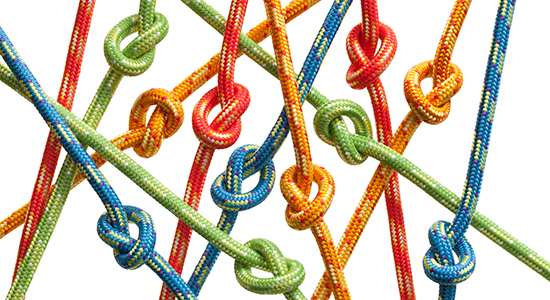
One of the most important aspects of resilience involves developing a flexible way of thinking about challenge and adversity and being able to solve problems in an accurate way. Design thinking is a type of innovation methodology – a problem-solving process to help you generate options, test strategies, and get feedback so that you can develop something (often applied to facilitate the creation of new products or processes). As I discovered, design thinking is also a great tool to help you get unstuck and problem solve life’s biggest challenges.
Design thinking can help you craft a more meaningful life, create the type of relationships you want after a divorce or breakup, or open up new pathways at work. Here is how I used design thinking1 to help me identify a new career path (and save lots of time and money in the process) when I burned out back in 2009.
1. Observe
If you were going to design a new product, you would first learn all about the end-user to identify pain points and patterns of behavior. In my application of design thinking, the end-user is you, and you have some work to do.
 Paula Davis-Laack, Marquette 2002, MAPP, is the founder of the Stress & Resilience Institute, a training and consulting firm focused on enhancing resilience, well-being, and engagement in the legal profession. She is the author of the e-book, Addicted to Busy: Your Blueprint for Burnout Prevention.
Paula Davis-Laack, Marquette 2002, MAPP, is the founder of the Stress & Resilience Institute, a training and consulting firm focused on enhancing resilience, well-being, and engagement in the legal profession. She is the author of the e-book, Addicted to Busy: Your Blueprint for Burnout Prevention.
What is the exact problem you’re trying to solve? This is an important question because you can lose years working on the wrong problem. The trick to uncovering the right problem is to think like a beginner and become curious.
Reframe counterproductive thinking. Your automatic negative thoughts (“ANTs”) about stress can cause you to miss crucial information. As a result, you need to be able to quickly reframe ANTs in order to think more flexibly and accurately.
Cut yourself some slack. Self-compassion involves being kind to yourself, getting support from others, and taking a balanced approach to your emotions.2
The problem I decided to get curious about was, “What do I love doing at work?” I had ANTs about feeling like a failure for quitting my law practice, but I soon realized that many thousands of lawyers had done the same thing. Practicing law is simply one of many things you can do with a law degree.
2. Ideate
Too often, people get stuck chasing their first idea or trying to find one perfect idea or solution to a problem, which rarely works. My first idea was to become a pastry chef. I was so certain of it, in fact, that I applied to pastry school in New York and told my boss that I was quitting. Thankfully, I had the sense to do an internship for a week, only to realize that I hated it – hated every minute of it.
It’s important to withhold judgment during this step and create as many ideas as possible, even those you might consider to be wild and outside the box. In design thinking, more is better when it comes to idea generation.3
You can lose years working
on the wrong problem.
The trick to uncovering
the right problem is to
think like a beginner and
become curious.
Back at square one, I realized that I had to generate more ideas and possibilities, so I created what I called “The List.” I wrote down all the things I had loved to do in my life, going back to childhood. I thought about all the things that excited me, how I used my strengths, when I was happy, and I made a list. I didn’t edit it at all – I simply captured every idea or memory that came into my head and my heart. When I was done, the following themes emerged: writing, research, talking to people, teaching, and traveling.
3. Rapid Prototyping
Take your ideas and conduct small experiments. Prototypes should be designed to get some data about what you’re interested in so you can visualize alternatives in a very experiential way. Most importantly, prototypes allow you to try and fail rapidly. The easiest form of prototyping is a conversation.4
My pastry internship is an example of rapid prototyping. That internship saved me $40,000 in tuition (and potentially hundreds of thousands of dollars starting a bakery) and forced me to identify other ideas, which led me to a more feasible solution quicker. After I developed the list, I had dozens of conversations with people who had careers that I thought matched my list ideas. I talked to a local reporter, reviewed the requirements for Ph.D. programs in psychology, interviewed business owners about entrepreneurship, and talked to life coaches.
It’s important to withhold judgment during this step and create as many ideas as
possible, even those you might consider to be wild and outside the box.
4. Feedback and Iteration
What did you learn from your small experiments? What worked? What didn’t? Do you need to have additional conversations with anyone or take additional action steps? Take that information and make changes to your prototypes as necessary until you fine-tune your solutions.
The reporter I talked to was clearly burned out and wasn’t inspiring. I learned how hard it is to start a business from scratch, and I discovered that I didn’t want to spend the next five years of my life pursuing another doctoral degree. However, one of the life coaches I talked to had just completed her master’s degree in applied positive psychology. I had never heard of positive psychology, but I was intrigued. I talked to more people who had graduated from that program (prototyping), researched the professors and the school (prototyping), learned how much it would cost and talked about expenses with my family (more feedback and iteration), then decided to apply.
5. Implementation
Once you have validated the utility of your solution, it’s time to act. In my case, I applied to the positive psychology program at the University of Pennsylvania and was accepted.
Design thinking is a problem-solving process that can help you build your resilience and get unstuck. If it seems overwhelming, remember these three points: get curious, talk to people, and try stuff.5
Endnotes
1 Spencer Lanoue, IDEO’s 6 Step Human-Centered Design Process: How to Make Things People Want (July 9, 2015).
2 Juliana G. Breines & Serena Chen, Self Compassion Increases Self-Improvement Motivation, Personality & Soc. Psychol. Bull. 1-11 (2012). See also the research and resources by Dr. Kristin Neff at www.self-compassion.org.
3 Bill Burnett & Dave Evans, Designing Your Life: How to Build a Well-Lived, Joyful Life 66-70 (New York, NY: Alfred A. Knopf 2016).
4 Id. at 111-19.
5 Bill Burnett, Designing Your Life, TEDxStanford
